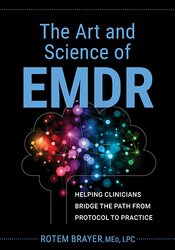What to Do When Clients Dissociate
Learn five effective techniques for orienting your client back to the present moment

Although many therapists are afraid of working with clients who dissociate, the reality is that dissociation is a normal human function. In fact, according to the National Alliance on Mental Illness (NAMI), 75 percent of us will dissociate at some point in our lives without being assigned a clinical diagnosis. Dissociation lies on a continuum, ranging from occasional incidents of daydreaming or “spacing out” to the more intense experiences of derealization and identity confusion. So it’s not a matter of if your client will dissociate, it’s a question of how much.
Therefore, instead of fearing dissociation, I encourage you to embrace the dissociated mind and be prepared for when it inevitably happens in session. Normalizing the experience of dissociation is important—not just for the preparation of the therapist but for the well-being of the client. What makes the difference between “adaptive” dissociation and “maladaptive” dissociation is the client’s awareness of the dissociative process and their ability to bring themselves back to the present. In therapy, you always want to avoid maladaptive dissociation and detect it when it happens.
When clients dissociate, they can lose orientation to the present, as they tend to travel back in time, most often to a moment of trauma in their past. One way to understand dissociation is by understanding your clients’ internal system through the lens of parts work. Parts work therapies believe each client has multiple parts, and each part has different ways of thinking, different emotional states, and different models of reality. Some parts, mostly younger and hurt ones, tend to dissociate in response to intense emotions. Taking advanced trainings and consultations in parts work can help take your therapy to the next level, but there are several strategies you can use right now for clients who are dissociating.
First, take a breath and remind yourself that your client is okay—they are in a safe place with you. Now, you have a very clear short-term goal: to orient them to the present moment, to what’s in front of them. Try one of the following techniques:
Once you are able to reground your client in the here and now, proceed with caution. Some clients get overwhelmed by the dissociative experience and the sudden loss of orientation. They may or may not be ready to immediately resume therapeutic work. They may need a break, and the best way to find out what they need is to simply ask them.
Therefore, instead of fearing dissociation, I encourage you to embrace the dissociated mind and be prepared for when it inevitably happens in session. Normalizing the experience of dissociation is important—not just for the preparation of the therapist but for the well-being of the client. What makes the difference between “adaptive” dissociation and “maladaptive” dissociation is the client’s awareness of the dissociative process and their ability to bring themselves back to the present. In therapy, you always want to avoid maladaptive dissociation and detect it when it happens.
When clients dissociate, they can lose orientation to the present, as they tend to travel back in time, most often to a moment of trauma in their past. One way to understand dissociation is by understanding your clients’ internal system through the lens of parts work. Parts work therapies believe each client has multiple parts, and each part has different ways of thinking, different emotional states, and different models of reality. Some parts, mostly younger and hurt ones, tend to dissociate in response to intense emotions. Taking advanced trainings and consultations in parts work can help take your therapy to the next level, but there are several strategies you can use right now for clients who are dissociating.
First, take a breath and remind yourself that your client is okay—they are in a safe place with you. Now, you have a very clear short-term goal: to orient them to the present moment, to what’s in front of them. Try one of the following techniques:
- Ask your client to take their shoes off. Guide your client to feel the ground and notice the subtle sensations in their feet.
- Use an essential oil diffuser. Keep a diffuser in a central location in your office, and turn it on with a grounding smell, such as lavender.
- Play pass with your client. Use a stress ball or other small object and pass it back and forth between the two of you.
- Have your client use their senses. Ask your client to identify three things they see, two that they hear, and one that they sense in the room.
- Have your client count. They can count sheep, go from 1 to 100, or subtract sevens from a number like 1,569.
Once you are able to reground your client in the here and now, proceed with caution. Some clients get overwhelmed by the dissociative experience and the sudden loss of orientation. They may or may not be ready to immediately resume therapeutic work. They may need a break, and the best way to find out what they need is to simply ask them.
The Art and Science of EMDR

Therapists who are trained in EMDR can facilitate healing in the most profound ways. But successful treatment requires more than following a rigid script or a protocol. It requires bringing both the art and science of EMDR into the therapy room.
In The Art and Science of EMDR, clinicians will learn how to do just that. Grounded in the principles of neurobiology and the science of deliberate practice, this book teaches both new and seasoned EMDR clinicians how to apply the phase-based model of EMDR in a more holistic way. Instead of conceptualizing EMDR in an inflexible and linear manner, clinicians will learn how to adapt the protocol to each client’s needs while maintaining authenticity to the model (and to who they are as therapists and humans).
In The Art and Science of EMDR, clinicians will learn how to do just that. Grounded in the principles of neurobiology and the science of deliberate practice, this book teaches both new and seasoned EMDR clinicians how to apply the phase-based model of EMDR in a more holistic way. Instead of conceptualizing EMDR in an inflexible and linear manner, clinicians will learn how to adapt the protocol to each client’s needs while maintaining authenticity to the model (and to who they are as therapists and humans).
Meet the Expert:
Rotem Brayer, MEd, LPC, is a licensed professional counselor, certified EMDR therapist, EMDR consultant, and advanced EMDR trainer. He is the founder of The EMDR Learning Community (emdr-learning.com), a community that brings EMDR therapists together and provides education on EMDR therapy and the integration of this modality with other treatment approaches. As the founder of EMDR Denver, a practice that helps clients heal with an "EMDR first" approach, Rotem divides his time between consulting on cases, coaching EMDR therapists, and helping clients heal from the effects of trauma and attachment wounds.
Learn more about his educational products, including upcoming live seminars, by clicking here.
Learn more about his educational products, including upcoming live seminars, by clicking here.





